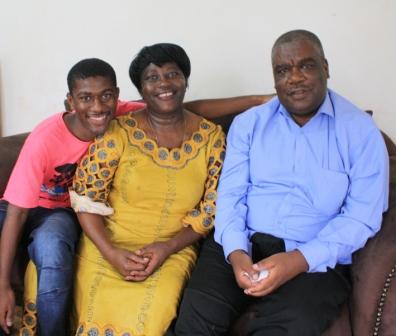It is every parent’s hope to see their children display above-average academic performance in school. It is common to hear parents talking so proudly about their children’s academic achievements as though these were a reflection of the parents’ academic brilliance. In this regard, my wife, Joyce, and I are certainly no different from the average parent. We have always wanted our children to do well in school.
We were, therefore, worried when our last born son, Alfayo, showed below-average progress in his primary reception class writing and reading homework. My wife wrote a note to his class teacher, Mrs. Maureen Kashikula, a white English family friend of ours in Kitwe.
Mrs. Kashikula sent the following reply:
“Yes, Alfayo does have a problem with written work. He has poor hand control – not uncommon at his age and it does improve as they mature – so don’t panic. However, to help him, just give him lots of practice in drawing, colouring and using scissors to cut. These are all activities which help develop manual dexterity.”
Mrs. Kashikula was to later confirm to us that Alfayo’s problems were due to a condition referred to as dyslexia. She clearly explained the meaning of the term and assured us that it was not a life-sentence on our son. She told us that we would need to work with him and to show a great deal of patience because the “cure” takes years.
According to the Microsoft Encarta Dictionary, “dyslexia is the impaired ability to understand written language: a learning disorder marked by a severe difficulty in recognizing and understanding written language, leading to spelling and writing problems. It is not caused by low intelligence or brain damage.”
To understand Alfayo’s condition, I took great interest in reading as many articles as I could about dyslexia. This reading was very helpful in helping me devise a strategy for helping Alfayo cope with his condition.
Through my reading I came across references to a book written by Dr Bevé Hornsby on the subject entitled, “Overcoming Dyslexia.” According to Dr Hornsby, children suffering from dyslexia may exhibit the following difficulties:
-
Reading very slowly and hesitantly while following text with their finger.
-
Constantly losing place, either missing out whole chunks or reading the same passage twice.
-
Reading aloud unfluently, word by word, with little change of intonation, like a computerized voice.
-
Reading only in the present tense although the text is in the past, for example: ‘The black cat came to my house. She put her kitten by the door,’ might read as: ‘The black cat comes to my house. She puts her kitten by the door.’
-
Guessing widely at words regardless of whether they make sense or not: ‘huge’ for ‘hurt’, ‘turned’ for ‘trainer’ for example.
-
Reading words backwards: ‘on’ for ‘no’, ‘saw’ for ‘was’, ‘pam’ for ‘map’, ‘god’ for ‘dog’.
-
Putting syllables in the wrong order, reading ‘animal’ as ‘aminal’. ‘hospital’ as ‘hopsital’, ‘enemy’ as ‘emeny’. Or doing the same with words: ‘Is she’ for ‘she is’.
Dr Hornsby also writes that dyslectics will write letters in the wrong order like ‘Simon’ spelt ‘Siomn’, ‘time’ as ‘tiem’, and ‘child’ spelt ‘chidl’.
Apart from reversing letters – ‘b’ for ‘d’, ‘p’ for ‘q’, they also mirror-write words such as ‘nomiS, for Simon’.
Dyslexics are also known to transpose letters, writing ‘n’ as ‘u’, ‘m’ as ‘w’, ‘d’ as ‘q’, ‘p’ as ‘b’. ‘f’ as ‘t’, et cetera.
Alfayo showed almost all of the faults listed above. Besides these faults, we noticed some interesting behaviours. Alfayo’s ability to speak was rather delayed. At one time, my wife contemplated the traditional method of cutting somewhere at the back of the tongue with a razor blade to aid his speech. In time, however, Alfayo did speak. But his first vernacular words were said in reversal. Instead of saying, “I want food”, he would instead say, “Food want I”.
His hand control was quite poor. He had difficulties holding a fork properly and manipulating it to eat. He also had difficulties tying his shoe laces. I also noticed Alfayo’s preference for a disorganized environment. He has never been comfortable with organized space up to this day. I have never been able to figure out what this has to do with dyslexia.
However, in other areas of life that did not involve reading and writing, Alfayo displayed remarkable intelligence. His oral comprehension was excellent, as was his grasp of spoken English.
In 1996, my friend, Dr John Sendama, who had just returned to Zambia from abroad where he had been studying, suggested that I expose Alfayo to computers so that he could develop his computer skills as he seemed to show a remarkable aptitude in this area. This suggestion turned out to be the most significant single factor in boosting Alfayo’s self confidence.
I conducted several one-to-one sessions in Achievement Motivation for Alfayo. I also provided information aimed at disproving the myth about the direct link between academic excellence and success in life.
My wife, Joyce, played the usual traditional role of encouraging and pushing Alfayo to do his best in school. This proved very valuable in helping Alfayo to see himself as no worse than other children in school.
In spite of our support, Alfayo continued to have challenges at school. The negative attitude of teachers and other children in school towards him made him dislike school. At one point, unknown to us then, he stopped going to school altogether. When we eventually discovered this, we decided to move him to a more friendly school where he made much progress in his school work.
There are many children with Alfayo’s condition who have been condemned to a life of failure because of society’s ignorance about dyslexia.
Some of the suggestions made by Dr Hornsby in his book referred to above may prove helpful to parents of dyslexic children:
Whatever your child's attitude, remember that you have a vital role to play in the fight against dyslexia and that your commitment to his progress will probably make all the difference. You have the opportunity to give the valuable one-to-one attention that may otherwise be lacking.
- Try to motivate your child without putting on too much pressure. Rather than devising extra work at home and continually pointing our mistakes, spend as much time as you can playing educational games, praise even the smallest achievement, and encourage him (or her) to build on strengths as well as to tackle weaknesses.
-
Don’t lose your temper if your child is not progressing as fast as you would like, or is slow on the uptake. Overcoming the problems associated with dyslexia can take a long time – and a lot of patient, hard work on everyone’s part.
-
If either you or your child becomes angry or frustrated while working together on reading and writing (as happens in many dyslexics’ families), leave it for a time, until the tensions have eased.
-
Keep in touch with your child’s teachers, both the regular schoolteacher, and the dyslexia specialist (if you have one). If all of you pool your information, then any problems can be dealt with more effectively. Also, if you decide to give any extra work at home, make sure the teachers know what you are trying to do.
-
Make an effort to meet other parents with dyslexic children. Your local dyslexia organization may be able to put you in touch with families in your area; or friends and neighbors might well know of others.
Dr Hornsby concludes this section with the following advice:
“The message I try to put across to my dyslexic pupils is: ‘Have confidence in yourself. You are just as bright as other children and it’s not your fault that reading and writing are so difficult for you. On the other hand, you may well have to work harder than they do to achieve what you want from life. But this is no bad thing. When you have worked hard for nothing, you appreciate it so much more than if everything comes easily.’”
My wife and I have not been perfect in following all of Dr Hornsby’s advice but we can attest to the fact that following the above advice has helped Alfayo to turn out into a well-adjusted person. He is now pursuing a formal course in computers, an area in which he has proved to be a genius of sorts.
I would like to end my discussion by referring to a humorous story in an article by James McCandlish, entitled “The teacher Who Couldn’t Dead”, and published in the ‘YOU’ magazine of June 2000. James tells the story of John Corcoran, who hid his inability to read for 48 years. For 17 years he taught English – without being able to read a word. John was a teacher with two degrees in education and business administration. John was 48 when he finally learnt how to read.
John was successful at school and in business.
“I did it all by pulling every trick in the book to hide my shameful secret,” he says. “I wasn’t dumb. I suffered from a reading disorder called dyslexia, which meant I couldn’t understand written words or connect them with speech.”
______________________





Posted it on twitter!
I want to take this case serious as less has been collected from the Education Sector in Zambia. Thank you for the remarkable data